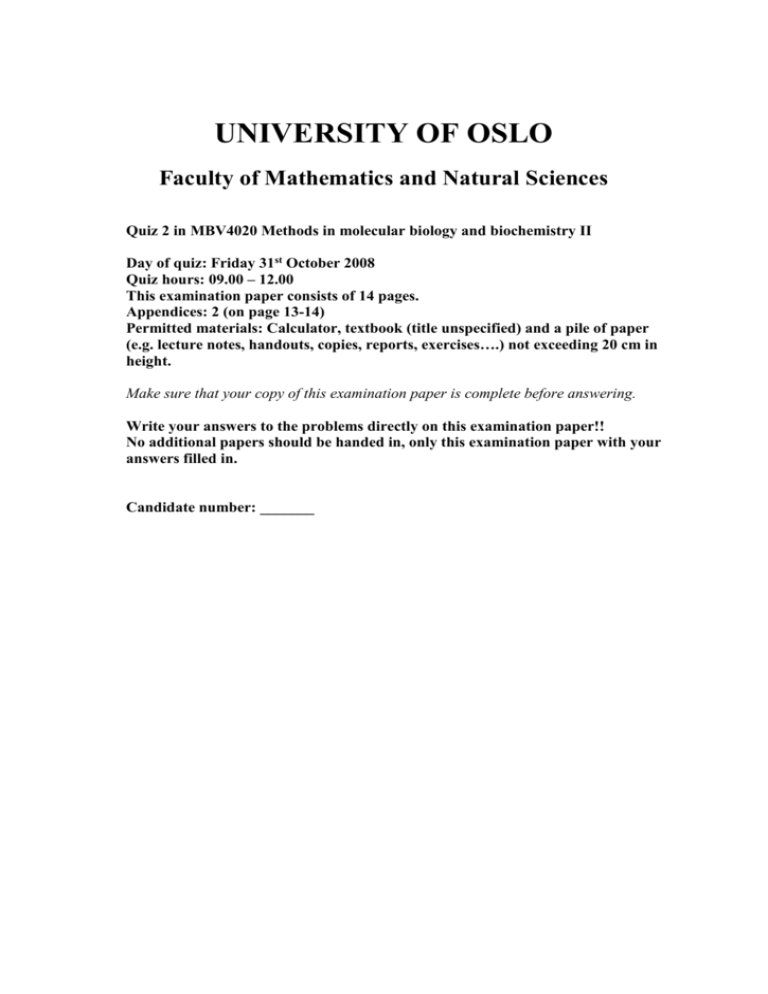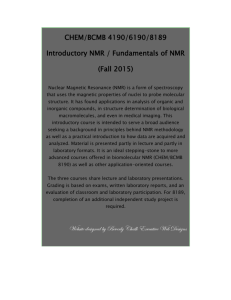NMR
advertisement

UNIVERSITY OF OSLO Faculty of Mathematics and Natural Sciences Quiz 2 in MBV4020 Methods in molecular biology and biochemistry II Day of quiz: Friday 31st October 2008 Quiz hours: 09.00 – 12.00 This examination paper consists of 14 pages. Appendices: 2 (on page 13-14) Permitted materials: Calculator, textbook (title unspecified) and a pile of paper (e.g. lecture notes, handouts, copies, reports, exercises….) not exceeding 20 cm in height. Make sure that your copy of this examination paper is complete before answering. Write your answers to the problems directly on this examination paper!! No additional papers should be handed in, only this examination paper with your answers filled in. Candidate number: _______ NMR All of the Questions should be possible to answer by only a few words or a simple calculation. Space given should be sufficient to answer all questions. The assignment exercise (Problem 6) counts two times the others NMR problems (Problem 15). In total the NMR part gives 45 points. Problem 1 For which of these applications may NMR be used. To obtain full points on this exercise you will have to have all questions correct. For one error 2/3 points will be given and for 2 errors 1/3 points will be given to students with no more than one error below. Right Wrong NMR may be used to study interactions between proteins and ligands. NMR may be used to study the structure of a peptide in water solution. NMR may be used to obtain the structure of organic compounds. NMR may be used to study DNA. NMR may be used to obtain structural information on proteins and peptides dissolved in organic solutions. NMR may not be used to study proteins that do not crystallize. NMR may not be used to study interaction between proteins. NMR may not be used to study local dynamics of molecules larger than 25 kDA NMR may not be used to study molecules that are larger than 500 kDa. Problem 2 Draw the 1D proton spectrum of ethanol. Remember to include all interactions and illustrate the peak intensities. 2 Problem 3 a.) Per Rogne has to determine the structure of his favorite protein/peptide it has the mass of 3135 Da (g/mol). Determine how much sample he will need for NMR structure determination. He is going to use a standard NMR instrument with a standard NMR tube (standard volume and concentration requirements). b) Will Per Rogne need to label his sample? c) What sort of NMR experiments will Per Rogne use to assign his sample? d) If Per Rogne could use COSY, TOCSY and NOESY, what sort of interactions would be responsible for the transfer of magnetization in the three techniques? You should put X at all correct answers! 1 2 3 4 JJJJThrough Through coupling coupling coupling coupling bond space interactions interactions (dipolar cross correlation) TOCSY NOESY COSY 3 Series of Jcoupling within a 3 2 J/ Jcoupled network Problem 4 What sort of NMR information gives structural information that may be used to calculate structures of large multi domain proteins? Do the methods give information about primary, secondary, tertiary or quaternary structure? Primary Secondary Tertiary Quaternary Only Non information of the on above dynamics/ Don’t know Per never told us/I may be to stupid to answer J couplings NOESY Color of protein Absorption at 280 nm Chemical shifts Torsion angles CSI index Frequency of the NMR instrument Residual dipolar couplings Problem 5 To what extent would you label the following proteins/peptides? a) A protein/peptide of 1234 Da (g/mol) for structure investigation. b) The dynamic properties of a peptide of 12348 Da (g/mol). c) 3D structure of a protein/peptide of 12348 Da (g/mol). 4 Problem 6. a) How many amid peaks do you expect a linear peptide of 10 residues to have, there are no ARG (R) , LYS (K), ASN (N), GLN (Q): b) We have obtained the TOCSY spectrum of a compound. The fingerprint region of the TOCSY spectrum is shown in the TOCSY spectrum (see below). Which of the following amino acids are observed in the specter? All expected peaks are observed in the spectrum. Do not look at the NOESY when you answer these questions as it may lead to the wrong answers. You have to have all answers right to obtain full points for this exercise. More than one answer may be right or wrong. Amino acid Would have to be in first position The amino-acid may be responsible for some of the observed peaks Proline, P Lysine, K Valine, V Phenylalanine, F Glutamine, Q Glutamic acid, E Glycine, G Argenine, R Serine, S Alanine, A Tryptophan, W 5 Would not be observed in the fingerprint region 6 c) Determine which of the following sequences that may be represented by the TOCSY above and the NOESY below. Only the fingerprint region is shown in the spectra. Write yes if the peptide may be represented by the two spectra and no if it may not. More than one answer may be right or wrong. Possible sequence The peptide may have this sequence WGASQV KGQQIF FGVAES GGVASE KKGEEWI IGASEV GASEV SIWEEG IGPASEV FGASEV 7 The peptide may not have this sequence 8 2DE/Proteomics Part I This part gives in total 25 points Problem 7 A comparison of human genome and human proteome reveal that there are 2,000,000 estimated human proteins, but only 23,000 genes. Give brief explanation for this discrepancy. (3 points) Problem 8 Give two examples of orthogonal protein separation (4 points) Problem 9 The plasma proteome has a very large abundance difference between proteins present, ranging from serum albumin to tumor necrosis factor alpha. When identifying a random plasma protein, what are the chances that this protein is albumin? (2 points) 1 in 2 1 in 5 1 in 10 Problem 10 You have three 2D gels and want to look for three proteins (1-2-3. below). Which gel (A-BC) will give best resolution for each protein? (6 points) Gels: A) IPG pH 4-7 + 6 %T SDS-PAGE B) IPG pH 7-11 + 10 %T SDS-PAGE C) IPG pH 3-10 + 12 %T SDS-PAGE 1. Cellular tumor antigen p53 (pI 6.48/ Mw 43,712 Da). Use gel __________ 2. Glyceraldehyde 3-phosphate dehydrogenase (pI 8.4/ Mw 35,622 Da). Use gel ________ 3. Desmoplakin (pI 6.2/ Mw 373,400 Da). Use gel __________ 9 Problem 11 You are going to analyze the protein histone H4 on a 2D IEF-SDS-polyacrylamide gel. Choose 1st and 2nd dimension parameters: (4 points) 1. IEF: pH 3-6 or pH 7-11. First dimension: pH _________ 2. SDS-PAGE: 5 or 10 or 15 %T. Second dimension: __________%T This is the amino acid sequence of Histone H4: MSGRGKGGKGLGKGGAKRHRKVLRDNIQGITKPAIRRLARRGGVKRISGLIYEETRGVLK VFLENVIRDAVTYTEHAKRKTVTAMDVVYALKRQGRTLYGFGG (103 amino acids) Use Appendix A: for amino acids pI values/ molecular weight Problem 12 You expect to have less than 10 ng of protein sample per spot. What staining technique(s) should you avoid? (2 points) Problem 13 This is a protein pattern of regucalcin found on a 2D gel. Suggest possible modification(s) in each position A-B (4 points). A: B: 10 Bioanalytical Mass Spectrometry/Proteomics Part II This part gives in total 30 points. Problem 14 A protein spot on the 2 D gel should be identified. Please describe your strategy in ca. 5 sentences (8 points): Problem 15 Why it is almost impossible to visualize the complete proteome of e.g. Neisseria gonorrhoeae on a 2 D gel (4 points)? Problem 16 What is Peptide Mass Fingerprinting (4 points)? 11 Problem 17 What is the monoisotopic mass (peak) (4 points)? Problem 18 What is tandem mass spectrometry (3 points)? Problem 19 How do you determine the charge state of a peptide (4 points)? Problem 20 A peptide with a mass of (MW 3467.84 –neutral-) is detected as triply protonated (charged) species in the MS (3 points). As which signal does this peptide “appear” in the MS-spectrum?....................................... 12 Appendix A: Average amino acid molecular weight: 118.2 Da Specific amino acid values: 13 Appendix B: 14





